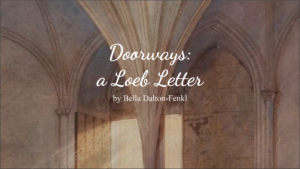Along with Vassar College, the Art Center is celebrating the sesquicentennial anniversary of our founding. In this weekly feature, we will look back on the rich 150-year history of the collection. Today’s post comes from Joseph Brichacek, Vassar College class of 2012 and Art Center student docent.


One anonymous student’s account of Professor Henry Van Ingen describes him as a “burly Dutchman reared within sound of Antwerp chimes- [He] has a homely, kindly face and very approachable manners, but stands no nonsense.” Born in The Hague, the Kingdom of the Netherlands in 1833, Van Ingen was Vassar College’s first professor of art. His career in art began when he studied at the Academy of Design at The Hague from 1844-1858. There his teachers were known as landscapists and he was further immersed in landscape painting under the apprenticeship of Hendrikus van de Sande Vakhuzen (1795-1860).
Van Ingen moved to the United States in 1861 when he was in his late twenties. But Van Ingen never broke with his Dutch heritage and he kept track of Dutch art while maintaining close ties with that community. Van Ingen began teaching at the University of Rochester, but, through connections and suggestions to the Vassar College administration, Henry Van Ingen was then hired by Vassar College and served as head of the art program from 1865 to 1898. He remained at Vassar for the rest of his life, taking occasional trips back to Europe to study and observe. These exploratory trips were funded by the administration for both educational reasons and also in thanks for his “faithful and efficient service.”
In addition to being a vital part of the formative years of arts education at Vassar College, Van Ingen was a practicing artist. Knowledge of his works is mainly sustained through his legacy at the college, but his work elucidates the interesting relationships between Dutch and American art in the late nineteenth century. Van Ingen was heavily influenced by The Hague School which was a movement that sought to return Dutch art to its notable traditions of specialty paintings, seashore life, interiors, and above all, landscapes of the Dutch countryside. Because of this influence and his training in the Netherlands, Van Ingen primarily painted landscape, genre, and animal paintings, while also working the fields of watercolor and etching. In 1862, 1867, and 1874 some of his works were published in the Dutch periodical Kunstronyk showing his continuing involvement in his homeland.
In many ways his work parallels are larger trend of mutual Dutch and American influence in the period between 1870 and 1900. His landscape paintings relate the principles of The Hague School to the scenery of the Hudson River Valley. In fact, it can be said that throughout his body of work, Van Ingen painted within the Dutch tradition but with an American cast. This included very American themes in animal paintings, such as Eagle (1873), and landscapes, such as View of Washington’s Headquarters (1883) (above). But Van Ingen never wholly subscribed to any artistic movement. He never painted using the emotional grays preferred by The Hague School (which was for this reason also referred to as “The Gray School”) but rather used a wider array of colors and brushwork that could be considered impressionistic. By not adopting the ideological limitations or doctrine of an art movement, Van Ingen could have only enhanced his ability to teach art to his pupils without bias and with appreciation for many different approaches.
While his work as an artist helps us appreciate the nuances of how European artistic traditions intersect with the American experience, the heritage the Vassar Community has in Van Ingen is perhaps most relevant as a much beloved professor and in his efforts in establishing the Vassar College tradition of art education. Perhaps one of his students summed up his professorship best, “you know how dear our Art teacher, Prof. Van Ingen is. He makes the girls feel so much at home in the studio and takes a world of interest in their work.”
More can be read on Van Ingen and other Vassar College topics at the Vassar Encyclopedia.




